Advertisements
Advertisements
प्रश्न
Find the potential difference `V_a - V_b` between the points a and b shown in each part of the figure.
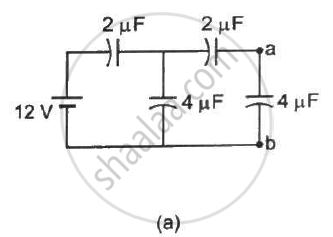
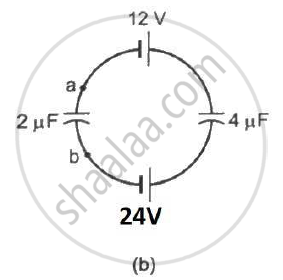
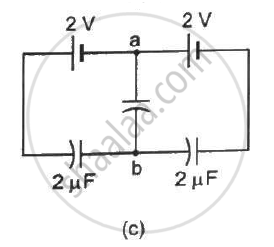
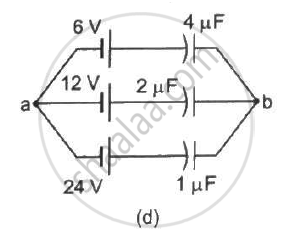
उत्तर
(a) `q = q_1 + q_2 ..........(1)`
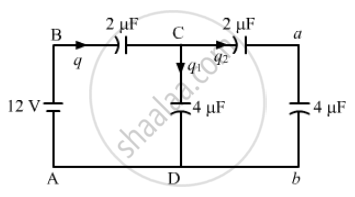
On applying Kirchhoff's voltage law in the loop CabDC, we get
`q_2/2 + q_2/4 - q_1/4 = 0`
`⇒ 2 q_2 + q_2 - q_1 = 0`
`⇒ 3 q_2 = q_1 .............(2)`
On applying Kirchhoff's voltage law in the loop DCBAD, we get
`q/2 + q_1/4 - 12 = 0`
`⇒ (q_1+q_2)/2 + q_1/4 - 12 = 0`
`⇒ 3q_1 + 2q_2 = 48 ............(3)`
From eqs. (2) and (3), we get
`9 q_2 + 2 q_2 = 48`
`⇒ 11q_2 = 48`
`⇒ q_2 = 48/11`
Now,
`V_a - V_b = q_2/(4 "uF") = 48/44 = 12/11 V`
(b) Let the charge in the loop be q.
Now, on applying Kirchhoff's voltage law in the loop, we get
`q/2 + q/4 - 24 +12 = 0`
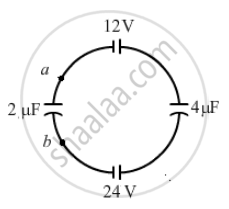
`⇒ (3 q)/4 = 12`
`⇒ q = 16 "uC"`
Now ,
`V_a - V_b = (-q)/(2 "uF")`
`⇒V_a - V_b = (-16 "uC")/(2 "uF") = -8V`
(c) `V_a - V_b = 2-(2-q)/(2 "uF")`

In the loop,
`2+2-q/2-q/2 = 0`
`⇒ q = 4C`
`therefore` `V_a - V_b = 2-4/2 = 2-2 = 0 V`
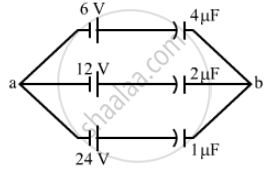
Net Charge flowing through all branches, `q = 24+24+24 = 72 "uC"`
Net capacitance of all branches, C = 4 + 2 + 1 = 7 μF
The Total potential difference (V) between points a and b is given by
`V= q/c`
`⇒ V = 72/7 = 10.3 "V"`
As the negative terminals of the batteries are connected to a, the net potential between points a and b is -10.3 V .
APPEARS IN
संबंधित प्रश्न
Distinguish between Conductors and Insulators.
Draw a labelled diagram of Van de Graaff generator. State its working principle to show how by introducing a small charged sphere into a larger sphere, a large amount of charge can be transferred to the outer sphere. State the use of this machine and also point out its limitations.
In the figure shown, an ammeter A and a resistor of 4 Ω are connected to the terminals of the source. The emf of the source is 12 V having an internal resistance of 2 Ω. Calculate the voltmeter and ammeter readings.
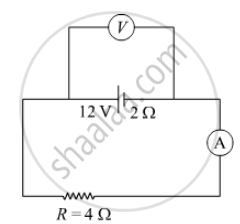
A metal rod of square cross-sectional area A having length l has current I flowing through it when a potential difference of V volt is applied across its ends (figure I). Now the rod is cut parallel to its length into two identical pieces and joined as shown in figure II. What potential difference must be maintained across the length of 2l. so that the current in the rod is still I?

Explain the principle of a device that can build up high voltages of the order of a few million volts.
Draw a schematic diagram and explain the working of Van de Graff generator device.
A test charge ‘q’ is moved without acceleration from A to C along the path from A to B and then from B to C in electric field E as shown in the figure. (i) Calculate the potential difference between A and C. (ii) At which point (of the two) is the electric potential more and why?
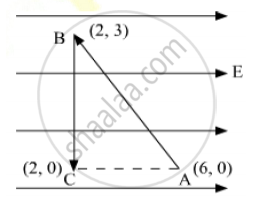
The figure shows a plot of three curves a, b, c, showing the variation of photocurrent vs collector plate potential for three different intensities I1, I2and I3 having frequencies v1, v2 and v3 respectively incident of a photosensitive surface.
Point out the two curves for which the incident radiations have same frequency but different intensities.
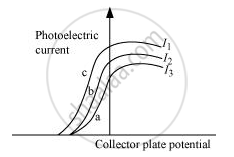
A charge of 20 µC is placed on the positive plate of an isolated parallel-plate capacitor of capacitance 10 µF. Calculate the potential difference developed between the plates.
The capacitance between the adjacent plates shown in the figure is 50 nF. A charge of 1.0µC is placed on the middle plate. If 1.0 µC is placed on the upper plate instead of the middle, what will be the potential difference between (a) the upper and the middle plates and (b) the middle and the lower plates?
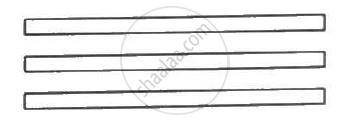
Two capacitors of capacitance 20⋅0 pF and 50⋅0 pF are connected in series with a 6⋅00 V battery. Find (a) the potential difference across each capacitor and (b) the energy stored in each capacitor.
In circuits, a difference in potential from one point to another is often called ______.
On moving a charge of Q coulomb by X cm, W J of work is done, then the potential difference between the points is ______.
- It depends only on the initial and final position.
- It is the work done per unit positive charge in moving from one point to other.
- It is more for a positive charge of two units as compared to a positive charge of one unit.
A and B are two points in an electric field. If the work done in carrying 4.0C of electric charge from A to B is 16.0 J, the potential difference between A and B is:
Can there be a potential difference between two adjacent conductors carrying the same charge?
If potential difference between the two ends of a metallic wire is doubled, drift speed of free electrons in the wire ______.
